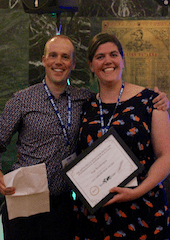
In early June, I attended the Kettil Bruun Society (KBS) meeting in beautiful Sheffield. It was the first time I attended KBS and it was quite different from other conferences I’ve been to. For the uninitiated: KBS is targeted at work in progress; specifically papers that have not been submitted for publication yet. Attendees submit their unfinished manuscript and receive detailed feedback from an allocated peer reviewer. For someone as nosy as I am, this conference is a perfect opportunity to find out about what everyone is up to at the moment and hear the latest news before it’s out there.
The conference was well-organized and had a great balance between research talks and opportunities to socialize. The research talks were very varied and with so many interesting talks going on at the same time, it was a real struggle to choose between the parallel sessions. My personal favourite was the session on declines in youth drinking. The speakers presented some thought provoking papers, which led to a very interesting discussion afterwards on the potential causes of recent declines in youth drinking.
Another conference highlight for me was the social tour to Kelham Island museum (and nearby pub). The KBS organizers had arranged for us to see the River Don Engine in action, which was spectacular, and I also got to chat to some great people in the pub afterwards. The other social aspects of KBS included a welcome reception, football in the rain (I have it on good authority that it was actually good fun), and of course the conference dinner. It was at the conference dinner that I received the Ole-Jørgen Skog award for my research on reducing alcohol serving sizes to reduce alcohol consumption. I’m very excited about this research and I’m honoured that the award committee was too.
We are currently preparing the manuscript for publication, but I’ll give you a sneak peek of the paper here. Our studies were primarily focused on examining whether we could nudge our participants to drink slightly less by reducing the serving size of alcohol provided. Appetite research shows that people eat more if they are served a larger portion of food. This effect has reliably been shown across a variety of foods and participant groups. Conversely, reducing the portion size of food also decreases how much people eat. Based on this, we hypothesized that reducing the serving size of alcoholic drinks would reduce people’s overall alcohol intake. We tested this hypothesis across two studies.
In the first study, we examined the effect of serving size reductions on alcohol consumption in a lab setting. We invited participants to a laboratory that was made to look like a living room, in order to measure alcohol consumption in an environment in which participants would feel comfortable consuming alcohol. We served half of the participants “normal” serving sizes of alcohol and the other half were served serving sizes that were reduced by 25%. Participants could order and consume as much alcohol as they wanted whilst watching a one-hour long TV programme, and this enabled us to examine whether people who were served the small servings would order more drinks to compensate for the serving size reduction. Our results showed that participants who were served the reduced serving sizes of alcohol drank significantly less overall than participants who received normal servings during the study.
Then, to see whether this effect would also be apparent in a naturalistic setting, we took this experiment to a local pub. We ran four pub quiz nights during which we manipulated the serving size of the drinks that people could buy. On two of the nights, the pub only sold standard servings of alcohol (pints, 175ml wine glasses) and on the other nights the pub only sold smaller servings (2/3 pints and 125ml wine glasses). There was no limit on the number of alcoholic drinks an individual was allowed to buy and the price was adjusted on the nights where we served smaller servings in order to ensure that value for money did not confound our results. A team of experimenters posed as participants and unobtrusively recorded how much every attendee drank during the night. We found the same pattern of results as in the lab study: On nights that we served smaller servings, people drank less than when we served standard servings. Taken together, these two studies suggest that reducing the standard serving size of alcohol could be an effective way to reduce population level alcohol consumption.
These studies are a very exciting first step in the direction of a population level intervention for alcohol reduction however, there are some things we can’t know yet based on these two studies. For example, we don’t know if the effect would extrapolate to heavy drinking occasions. It is also unclear whether people would show compensation for the reduced serving sizes once they are aware that it’s meant to make them drink less.
My experience of the KBS conference has been overwhelmingly positive. As an early career researcher, the feedback I got from the discussant and other attendees was invaluable. I am currently working on some follow up studies to examine the public acceptability of serving size reductions and I can’t wait to tell you all about it at KBS 2018 in Chiang Mai, Thailand.
Written by Dr Inge Kersbergen, Psychological Sciences, University of Liverpool.
All IAS Blogposts are published with the permission of the author. The views expressed are solely the author’s own and do not necessarily represent the views of the Institute of Alcohol Studies.
